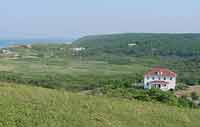Forge River-type Lifeboat Stations

Galloo Island (Lake Ontario)
New York
1937

In its current deteriorated condition,
its resemblance to the Port Orford station
is clear – note the use of cedar shingles.

Fire Island (Long Island)
New York
c. 1933

Munising (Lake Superior)
Michigan
1933

Pamet River (Cape Cod)
Massachusetts
c. 1937

Pamet River Station
Today a youth hostel

Port Orford (Pacific Ocean)
Oregon
1934
Most U.S. Coast Guard stations were built with designs or modifications unique to the West Coast. Between 1875 and 1915 the U.S. Life-saving Service (USLSS) utilized several architectural types for its stations in Oregon, constructing seven stations. The only remaining station built by the USLSS is in Tillamook County, constructed in 1908 at Bar View. Whereas earlier stations on the Atlantic and Gulf coasts incorporated the boathouse and the living quarters into one building, on the west coast, auxiliary boathouses were used, which allowed the stations to maintain the lifeboats in closer proximity to the water, eliminating the need to move them overland to the launching area. This was especially important in the case of Port Orford, with the boathouse 280 feet below the barracks building, connected by a staircase of over 530 steps.
Although the newly formed Coast Guard (created in 1915 by combining the Revenue Cutter Service with the USLSS) utilized architectural styles distinct from those of the USLSS, several stations were constructed using designs of USLSS architect Victor Mindeleff. Mindeleff had become the architect of the United States Life-Saving Service (USLSS) in 1898, and is considered the most prolific of the service’s architects – he served in that position longer than any other architect, and was responsible for at least 13 design styles. His last design for the USLSS was the Forge River-type station, designed in 1914. This type station was used on both East and West coasts and the Great Lakes. The design came to dominate U.S. Coast Guard architecture through the 1940s.
About 30 of the Chatham-type stations were built. The Port Orford Lifeboat Station is considered a Forge River-type, measuring 45 feet wide and 30 feet deep. The stations pictured here all resemble the Port Orford Lifeboat Station, some down to the last detail. The East Coast and Great Lake stations were painted white, while the Port Orford station was finished in unpainted cedar shingles and allowed to weather, giving it a particular Pacific Northwest appearance.
All Forge River-type stations had detached boathouses.
Read about Julius Yuhasz, the man who with his partner Arnvid Olson built the Port Orford Lifeboat Station.
Sources:
David Pinyerd, The Preservation of Pre-World War Two Coast Guard Architecture
in Oregon, University of Oregon, 2000
U.S. Coast Guard
Point Orford Heritage Society
National Park Service

